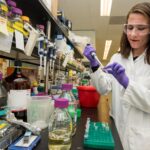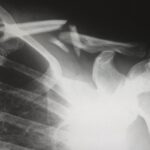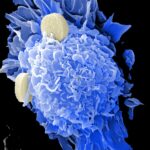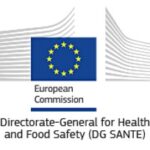 Most patients with alpha-1 antitrypsin deficiency remain undiagnosed and therefore do not benefit from current therapies or become eligible for research studies of new treatments under development. Improving the detection rate for AATD is therefore a high priority for the Alpha-1 Foundation. A workshop was held on June 23, 2019 in Orlando, Florida during which stakeholders from the research, pharmaceutical, and patient communities focused on the topic of alpha-1 antitrypsin deficiency detection. A variety of detection strategies have been explored in the past and new approaches are emerging as technology advances. Targeted detection includes patients with chronic obstructive pulmonary disease, unexplained chronic liver disease, and family members of affected individuals. Newborn screening, electronic medical record data mining, and direct-to-consumer testing remain options for future detection strategies. For more information click here.
Most patients with alpha-1 antitrypsin deficiency remain undiagnosed and therefore do not benefit from current therapies or become eligible for research studies of new treatments under development. Improving the detection rate for AATD is therefore a high priority for the Alpha-1 Foundation. A workshop was held on June 23, 2019 in Orlando, Florida during which stakeholders from the research, pharmaceutical, and patient communities focused on the topic of alpha-1 antitrypsin deficiency detection. A variety of detection strategies have been explored in the past and new approaches are emerging as technology advances. Targeted detection includes patients with chronic obstructive pulmonary disease, unexplained chronic liver disease, and family members of affected individuals. Newborn screening, electronic medical record data mining, and direct-to-consumer testing remain options for future detection strategies. For more information click here.
Publications
 Mitochondrial disorders are a group of rare diseases, caused by nuclear or mitochondrial DNA mutations. Their marked clinical and genetic heterogeneity as well as referral and ascertainment biases render phenotype-based prevalence estimations difficult. Here we calculated the lifetime risk of all known autosomal recessive mitochondrial disorders on basis of genetic data. We queried the publicly available Genome Aggregation Database (gnomAD) and our in-house exome database to assess the allele frequency of disease-causing variants in genes associated with autosomal recessive mitochondrial disorders. Based on this, we estimated the lifetime risk of 249 autosomal recessive mitochondrial disorders. Three of these disorders and phenylketonuria (PKU) served as a proof of concept since calculations could be aligned with known birth prevalence data from newborn screening reports. For more information click here.
Mitochondrial disorders are a group of rare diseases, caused by nuclear or mitochondrial DNA mutations. Their marked clinical and genetic heterogeneity as well as referral and ascertainment biases render phenotype-based prevalence estimations difficult. Here we calculated the lifetime risk of all known autosomal recessive mitochondrial disorders on basis of genetic data. We queried the publicly available Genome Aggregation Database (gnomAD) and our in-house exome database to assess the allele frequency of disease-causing variants in genes associated with autosomal recessive mitochondrial disorders. Based on this, we estimated the lifetime risk of 249 autosomal recessive mitochondrial disorders. Three of these disorders and phenylketonuria (PKU) served as a proof of concept since calculations could be aligned with known birth prevalence data from newborn screening reports. For more information click here.
 X-linked hypophosphataemia (XLH) rickets is a rare disease frequently misdiagnosed and mismanaged. Despite having clinical guidelines that offers some therapeutic recommendations based on the clinical experience of experts, physicians still have questions about some important aspects of the diagnosis and treatment of XLH, such as when the disease should be suspected, who should be in charge of the diagnosis, what should be done once the disease is diagnosed, or what therapeutic options are currently available. The objective of this paper is to answer some of the more frequent questions related to the management of patients with XLH by a group of experts participating in a scientific conference on XLH held in Madrid. For more information click here.
X-linked hypophosphataemia (XLH) rickets is a rare disease frequently misdiagnosed and mismanaged. Despite having clinical guidelines that offers some therapeutic recommendations based on the clinical experience of experts, physicians still have questions about some important aspects of the diagnosis and treatment of XLH, such as when the disease should be suspected, who should be in charge of the diagnosis, what should be done once the disease is diagnosed, or what therapeutic options are currently available. The objective of this paper is to answer some of the more frequent questions related to the management of patients with XLH by a group of experts participating in a scientific conference on XLH held in Madrid. For more information click here.
 Syringomyelia and Chiari Syndrome are classified as rare diseases, but current known occurrence in Europe is missing. The increased ability to diagnose these pathologies by magnetic resonance imaging and its widespread availability has led to an increase of reported cases, often asymptomatic, with the need to standardize definitions, diagnostic criteria and treatments. The aims of this study are to present shared Interregional Recommendations developed with the primary aim to estimate Syringomyelia and Chiari Syndrome prevalence and incidence in North Western Italy, with special reference to symptomatic forms. For more information click here.
Syringomyelia and Chiari Syndrome are classified as rare diseases, but current known occurrence in Europe is missing. The increased ability to diagnose these pathologies by magnetic resonance imaging and its widespread availability has led to an increase of reported cases, often asymptomatic, with the need to standardize definitions, diagnostic criteria and treatments. The aims of this study are to present shared Interregional Recommendations developed with the primary aim to estimate Syringomyelia and Chiari Syndrome prevalence and incidence in North Western Italy, with special reference to symptomatic forms. For more information click here.
 Hereditary spastic paraplegias (HSPs) are a heterogenous group of rare neurodegenerative disorders that present with lower limb spasticity. It is known as complicated HSP if spasticity is accompanied by additional features such as cognitive impairment, cerebellar syndrome, thin corpus callosum, or neuropathy. Most HSP families show autosomal dominant (AD) inheritance. On the other hand, autosomal recessive (AR) cases are also common because of the high frequency of consanguineous marriages in our country. This study aimed to investigate the clinical and genetic aetiology in a group of HSP patients. For more information click here.
Hereditary spastic paraplegias (HSPs) are a heterogenous group of rare neurodegenerative disorders that present with lower limb spasticity. It is known as complicated HSP if spasticity is accompanied by additional features such as cognitive impairment, cerebellar syndrome, thin corpus callosum, or neuropathy. Most HSP families show autosomal dominant (AD) inheritance. On the other hand, autosomal recessive (AR) cases are also common because of the high frequency of consanguineous marriages in our country. This study aimed to investigate the clinical and genetic aetiology in a group of HSP patients. For more information click here.
 Porphyria cutanea tarda (PCT) is a rare, photosensitive disease characterized by skin fragility and blistering on sun-exposed areas. There is little previous research on how this condition affects health-related quality of life (HRQoL) and to the best of our knowledge this is the largest sample of PCT patients surveyed about their HRQoL. The aims of this study were to describe HRQoL, symptoms, susceptibility factors, disease activity and treatment in patients with PCT, and investigate the associations between these factors. This is a cross-sectional, retrospective study based on patient-reported outcome and laboratory data. The Norwegian Porphyria Centre diagnoses all patients with PCT in Norway, all of whom are invited to participate in the Norwegian Porphyria Registry. Between December 2013-2015, 111 patients received a postal questionnaire and invitation to participate. For more information click here.
Porphyria cutanea tarda (PCT) is a rare, photosensitive disease characterized by skin fragility and blistering on sun-exposed areas. There is little previous research on how this condition affects health-related quality of life (HRQoL) and to the best of our knowledge this is the largest sample of PCT patients surveyed about their HRQoL. The aims of this study were to describe HRQoL, symptoms, susceptibility factors, disease activity and treatment in patients with PCT, and investigate the associations between these factors. This is a cross-sectional, retrospective study based on patient-reported outcome and laboratory data. The Norwegian Porphyria Centre diagnoses all patients with PCT in Norway, all of whom are invited to participate in the Norwegian Porphyria Registry. Between December 2013-2015, 111 patients received a postal questionnaire and invitation to participate. For more information click here.
Information Sources and Health Care Centres for Rare Diseases Among Affected People in Germany
 About four million people are affected by rare diseases in Germany and 30 million in the EU. In 2013, a national action plan for people with rare diseases was adopted in Germany which is also aimed at improving the information situation and better gathering of information for affected patients and their families. Since then, various sources of information and medical care structures have been made available. The aim of this study was to evaluate the state of knowledge about information sources and health care centres for rare diseases among those affected. For more information click here.
About four million people are affected by rare diseases in Germany and 30 million in the EU. In 2013, a national action plan for people with rare diseases was adopted in Germany which is also aimed at improving the information situation and better gathering of information for affected patients and their families. Since then, various sources of information and medical care structures have been made available. The aim of this study was to evaluate the state of knowledge about information sources and health care centres for rare diseases among those affected. For more information click here.
 Buschke-Ollendorff syndrome (BOS) is a rare genetic hereditary genodermatosis characterized by benign skeletal and cutaneous lesions. Skeletal alterations known as osteopoikilosis (OPK) or “spotted bone disease” are asymptomatic areas of sclerosing dysplasia. Two skin lesion patterns have been described because they may be of either elastic tissue (juvenile elastoma) or collagenous composition (dermatofibrosis lenticularis disseminata). We present the case of a 6-year-old male patient with yellowish papules that coalesced to form plaques localized on both thighs and on the upper limbs consistent with a connective tissue nevus (CTN) diagnosis. For more information click here.
Buschke-Ollendorff syndrome (BOS) is a rare genetic hereditary genodermatosis characterized by benign skeletal and cutaneous lesions. Skeletal alterations known as osteopoikilosis (OPK) or “spotted bone disease” are asymptomatic areas of sclerosing dysplasia. Two skin lesion patterns have been described because they may be of either elastic tissue (juvenile elastoma) or collagenous composition (dermatofibrosis lenticularis disseminata). We present the case of a 6-year-old male patient with yellowish papules that coalesced to form plaques localized on both thighs and on the upper limbs consistent with a connective tissue nevus (CTN) diagnosis. For more information click here.
 In the context of COVID-19 pandemic and launching of the ‘COVID-19 Clinical Management Support System’, DG SANTE is organising a series of webinars to support clinicians and other healthcare professionals at the frontline who treat the patients with COVID-19. We would like to invite you and any other colleague or healthcare professional of your hospital that might be interested, to the webinar: “ Cancer and COVID-19: current and future challenges” that will take place on Thursday 28 May, from 10:00 – 11:00 CET. It will feature Stella Kyriakides, Matthias Schuppe and many others. For more information click here.
In the context of COVID-19 pandemic and launching of the ‘COVID-19 Clinical Management Support System’, DG SANTE is organising a series of webinars to support clinicians and other healthcare professionals at the frontline who treat the patients with COVID-19. We would like to invite you and any other colleague or healthcare professional of your hospital that might be interested, to the webinar: “ Cancer and COVID-19: current and future challenges” that will take place on Thursday 28 May, from 10:00 – 11:00 CET. It will feature Stella Kyriakides, Matthias Schuppe and many others. For more information click here.
 Recent genome-wide analyses of rare and common sequence variations have brought greater clarity to the genetic architecture of pulmonary arterial hypertension and implicated novel genes in disease development. Transcriptional signatures have been reported in whole lung tissue, pulmonary vascular cells and peripheral circulating cells. High-throughput platforms for plasma proteomics and metabolomics have identified novel biomarkers associated with clinical outcomes and provided molecular instruments for risk assessment. There are methodological challenges to integrating these datasets, coupled to statistical power limitations inherent to the study of a rare disease, but the expectation is that this approach will reveal novel druggable targets and biomarkers that will open the way to personalized medicine. Here, we review the current state-of-the-art and future promise of ‘omics’ in the field of translational medicine in pulmonary arterial hypertension. For more information click here.
Recent genome-wide analyses of rare and common sequence variations have brought greater clarity to the genetic architecture of pulmonary arterial hypertension and implicated novel genes in disease development. Transcriptional signatures have been reported in whole lung tissue, pulmonary vascular cells and peripheral circulating cells. High-throughput platforms for plasma proteomics and metabolomics have identified novel biomarkers associated with clinical outcomes and provided molecular instruments for risk assessment. There are methodological challenges to integrating these datasets, coupled to statistical power limitations inherent to the study of a rare disease, but the expectation is that this approach will reveal novel druggable targets and biomarkers that will open the way to personalized medicine. Here, we review the current state-of-the-art and future promise of ‘omics’ in the field of translational medicine in pulmonary arterial hypertension. For more information click here.
